


|
 |
|
|
#1 |
|
Registered Member
Join Date: Sep 2007
Location: Melbourne, Australia
Posts: 379
|
Pinnate Batfish (Platax Pinnatus ) Success To Date
HI All, First of all for those who don't know, I have been privileged enough to be housing an Adult Pinnate Batfish for approx 3 years now. Over the years I'm yet to meet another person that currently has one (either here or on other forums - I'm not saying I'm the only person I just haven't found anyone yet) nor anyone that knows much about them other than what is published common knowledge ie.' They are impossible to keep alive'. So I was lucky enough to walk into my LFS one day and witness a sub-adult specimen that was eating flake food in front of me, which I quickly purchased. This started my interest for the species and I now felt it time to post my findings over the last few years, having now had some success with multiple Pinnate Batfish (Platax Pinnatus). I have kept my experiences to myself as I was concerned if it went south; a new division of the 'I told you so Police' would be created  Anyway after 4 attempts in a row now with juvenile\sub-adult Pinnate Batfish (approx 7cm tall - 10cm tall), I have managed to have all of them eating for 6+ months now and my Adult Pinnate Batfish for 3+ years or so, I'd like to think that this gives hope to long term success for others now. And for myself, to one day soon attempt in breeding them (if only there was a way to easily sex them). Basic Pinnate Batfish Stats: Family: Ephippididae Range: Indo-Pacific Size: Up to 20 inches Diet: Omnivore Minimum Tank Capacity: 760 Litres \ 200 gallons and 2ft Tall. Now the most common problem with Pinnate Batfish is their finicky eating habits whilst in captivity, commonly leading to their eventual mortality. I have found that of the 5 specimens personally observed in my Quarantine Tank, they were all willing to eat\try live brine\mysis\black worms (I am uncertain 5 is enough still been the exception to the rule or the norm yet). From this I was able to ween them onto eating frozen brine\mysis by feeding both (live and frozen) at the same time until they were only eating frozen brine\mysis. This was for a period of approx 1-2 weeks. After this through the success (or luck) of my original batfish I have learnt that the Pinnate Batfish will try a food out occasionally (including flake) that they are unfamiliar with, but will reject the food if they don't fancy it. I did notice though, that if the food particle was the right size (small enough) the batfish would swallow it (possibly by accident) unable to spit it back out. Once I realised this, I experimented by purchasing fresh smelly seafood's such as mussels, squid, whitebait, prawn, fish roe etc and cutting them by hand into the tiniest of pieces. When added to the water column any pieces floating near the Pinnate Batfish would be swallowed whole, progressively over a few days they would actively pursue the food. The issue remained that if a piece was too large the batfish would bite it and then spit it back out whole, anything too small would be ignored all together. Hand cutting seafood into minute pieces multiple times a day was incredibly painful and often if I rushed it, all of the food would be ignored due to it not being their preferred size. I then found the key, which was to freeze the frozen food and then use a cheese\vegetable hand grater to grate the frozen foods into small bite sized particles. What was also great is the fact that the grater had various sizes so that as the Pinnate Batfish grew I could use the larger sizes to grate. I have had 100% success with this method to date ALTHOUGH they have only been on frozen foods for 6+ months so far and I'm not waving the flag of victory yet. I have now moved one of my juveniles into the DT with the established Adult Pinnate Batfish to see how he interacts with the community fish and establish if he is now aggressive enough in his feeding to eat the same foods that the other fish are chasing. I have noticed that the Juvenile has settled in well enough, he has established his own territory and is not too alarmed if a fish decides to nip at him on their way through or bump into him (so to speak). I have observed him looking\searching for food very occasionally but never eating anything other than what I place in to the tank. He is certainly eating 'less' food than when I was able to focus feed him in the QT but is still eating enough for me not to be concerned (yet). Im finding I have to put 5x the amount of grated frozen food so that enough particles float around near his 'den' and smaller fish don't eat everything before he gets a chance. Whilst in QT one of the Pinnate Batfish got the 'Cauliflower' disease which covered a significant portion of its fins but thankfully not its gills. I was unsure about what to do but decided after doing some reading just to see if we could ride it out just by improving the water conditions in the QT instead. This seemed to be the solution as after doing more frequent water changes the symptoms noticeably disappeared over a 1-2 week period and then gone completely after a month or two (didn't affect his behaviour at all). Some general tips from what I've found if you're considering trying a Pinnate Batfish yourself: 1. Only buy a specimen from your LFS if you witness it eating at least live or frozen brine shrimp (I haven't yet tried getting one to eat that is refusing to eat anything and I don't really want to ever have to try). 2. Isolate specimen in a HT\QT so that it is on its own and has at least one decent hiding spot it can go inside (needs to be high enough for it to be able to float a good inch above the glass and still not have its top fin brushing against the top). 3. High quality water equivalent or greater to your DT. I do weekly water changes on my DT and run the water from my DT straight into the HT\QT each week doing a 100% diluted water change by removing the old water at the same time as filling it with the new. Ie. Don't drain the tank by half and then fill it back up with new water 4. If you don't want to have your Batfish in your HT\QT for 6+ months on its own (like I have been doing) then you're going to have to feed frequently to get some fat on its bones and encourage it to adjust more swiftly. After various experiments I found that my Batfish would happily eat 5-6 times a day if I fed it that often as long as there was a decent hour or so break in between. I got down to a stage where during week days I was feeding 2-3 times a day (threw a block of frozen mysis in the morning on the way out the door, as soon as I got home a cube equivalent of shaved frozen squid or prawn, and then a few hours later the same again). 5. Even after 6 months in the HT\QT I cannot 100% state that there isn't a chance you will need to re catch him and move him back from my DT as I'm aware there is a chance they can stop eating if they aren't happy\getting bullied. My original batfish was a freak of nature eating flake food and pellets on day 1, now eating ANYTHING I put in the water and I mean ANYTHING. I am HOPING this is a trait that my juvenile in the DT will take on now that he is growing\adjusting. 6. If you are blessed with success in getting your juvenile pinnate batfish to eat then make sure you place him in your DT as the 'FIRST' tank mate OR only with very placid\peaceful species . 7. If you're planning on keeping your Pinnate Batfish long term (and you should be) then you need to look at keeping them in a 2.5ft deep tank. I had mine originally in a 5ft x 2ft x 2ft and it became apparent he was becoming stressed due to a lack of swimming space as he grew. He is now comfortably in a 8ft x 2.5ft x 2.5ft and I cannot see him requiring anything larger now as he is near max size. The specs for my HT\QT: TANK - 3ft x 2ft x 18" SKIMMER - Reef Octopus Module 350 Combo FLOW - 1 x 5000L P/H Power Head HEATER - 2 x 150w LIGHTING - Standard 3ft T5 fitting IMPORTANT: A few extra large storm water plumbing joins for hiding and a plastic tub with very large holes cut in it with a rock holding it upside down in the HT (makeshift large cave) SPECIES OBSERVATION: 1. Temperament - The Pinnate Batfish is a VERY placid fish, inactive\minimal swimmer at day but very active at night (im yet to figure out when they sleep\rest). Don't be surprised if they just hover in a corner or cave and don't venture out during the day (unless they are spooked or feeding) but if you come with a torch at night you will definitely see them swimming around. NOTE: There is an exception to its placid nature and that is once my Adult Pinnate Batfish got large enough I witnessed on several occasions it would chase other fish of the same species if they attempted to eat his food at the same time. 2. Growth - In my now adult Pinnate Batfish, there has been rapid growth and is now my largest fish since I purchased him 3 years ago. When I first purchased him he was approx 18cm tall and is now 30cm in approx 2-3 years just to give you an idea of growth rate. 3. Compatibility - I have had a large variety of fish in my tanks over the years and can safely say that you need to be aware of the following: Nippers - I have witnessed my Sohal Tang, Moorish Idol, Tomato Clowns, Lawnmower Blenny and Ember Blenny attack my Batfish outright and attempt to cause him serious harm. I believe this came down to territory and the fact that the batfish was getting larger and the tank space smaller. You can generally tell from the bite marks who was doing what damage, thankfully the batfish healed up fairly quickly each time (2-3 weeks). The only defensive ability the batfish has is to spin around in a circle to scare off the attacker other than that he is pretty much helpless so the responsibility is on you to remove any aggressors before the batfish stresses to the point where he is refusing to eat (this has not happened to me yet but I am aware of this happening to others) 4. REEF SAFE? - I read in one of my books that the Pinnate Batfish eat corals and anemones. I honestly can say that to date none of my Pinnate Batfish have been seen to even nip at a single coral BUT my Adult Pinnate Batfish in the last few months has taken two bites out of my Red Haddoni Carpet Anemone. I am unsure WHY this is the case and WHY it's only NOW he's taken interest. He actually bit off the small ball shaped tentacles. It doesn't seem to have had any sort of negative effect on the anemone yet, other than the Anemone closing up for a few mins before reopening. The Batfish hasn't seemed to have gone back ALTHOUGH this issue would be totally eliminated if I had some clownfish hosting in it, which I do not. Instead I have two porcelain anemone crabs hosting in it which are useless defence from a distance and speed point of view. 5. Hardiness - I have found juveniles to be very weak and susceptible to illness if not treated delicately. Adult Pinnate Batfish on the other hand are incredibly hardy, my Adult has lived through 6-7 tank relocations and 3 complete tank crashes swimming around in an ammonia level of 0.5ppm for a night whilst others perished (not that I recommend that). I'm hoping from this post that people don't go out irresponsibly and buy a Pinnate Batfish. I'm not even stating that my experience is Gospel either. I would recommend that most people watch this space and I will continue to communicate every few months how my juvenile is going in the DT and we shall see if he loses his appetite or stays as he was in my QT\HT and eats like a pig. Thanks for taking the time to read, feel free to ask any questions.
__________________
Jason *A question never asked, is a question never answered. *Two people attempting something differently, doesn't make one of them wrong |
|
|

|
|
|
#2 |
|
Registered Member
Join Date: Dec 2008
Location: jacksonville florida
Posts: 1,441
|
Excellent read!! I really appreciate all the time and effort you have put in to this study. I've been interested in keeping one of these guys for a long time but never knew what was involved, maybe now I can start reseaching again because I have a 220 that I would love to have one in. I'm sure I'm going to have plenty of questions but for right now all I can ask is where the heck are the pictures to go along with that great post!!!!!
|
|
|

|
|
|
#3 |
|
Moved On
Join Date: Jun 2002
Location: Ohio
Posts: 1,971
|
Juvenile pinnatus, if handled well during the supply chain, and quarantined appropriately are a bit demanding, but not impossible.
Here is the text I wrote about Platax pinnatus in my 2006 book, Advanced Marine Aquarium Techniques, (C. TFH Pub.) The Red-rimmed Batfish, Platax pinnatus Unfortunate experiences that people have had with this species have taught most advanced aquarists to be very wary of this species. Large individuals, (8 to 12 inches tall) from the Philippines fared especially poorly. In speaking with other aquarists, it seems that there was a particular trend for juvenile specimens to live a bit better in captivity. By no means would one consider these smaller fish hardy, but there were at least some reports of moderate success. Bolstered by this information, I acquired a juvenile that showed a spark of interest in feeding, and which lived for five months after initially having to force-feed it to get it feeding on its own (Hemdal 1985). After the subsequent death of this animal due to an apparent bacterial infection and my later entry into a career with public aquariums, I had actively avoided acquiring any further specimens. During this time, (1985 to 1995) I still heard scattered reports of success of others with this fish through personal communications, the Internet and other media. It turns out that a surprising number of these reports were cases of mistaken identity. How any aquarist could confuse the red-rimmed batfish with the duller colored, but much hardier Platax tiera I don’t know, but this happened more than a few times. The facts of a few of the other reports were highly suspect based on the information presented. In the anonymous world of the Internet, it is very easy for a person to develop dialogues with others that stray a bit from the truth. Since there is no way to check the information being presented, some people have been known to create fictitious success stories about their aquariums so that they appear to be more expert than they really are. April fool’s day is a good time to see these sorts of messages posted on the Internet. A hobbyist once wrote an article for an aquarium club newsletter indicating good success feeding his red-rimmed batfish bananas (of all things!). This article relied on the premise that since juvenile batfish live in mangrove swamps, these fish must be adapted to feeding on fruit and other plant material. While this might apply to the round batfish, (Platax orbicularis) the red-rimmed batfish is a coral reef inhabitant; one juvenile was found in a cave at the base of a coral reef at a depth of 15 meters, (Randall & Emery 1971) quite far from any natural source of fruit as food. There were other discrepancies in the article, the author reported that his pair of fish grew to a size which was 2" taller than the height of the tank he had reported keeping them in. Being a natural cynic, I found only a half dozen or so of these success stories that I felt comfortable believing. One batfish I saw for myself had been raised from a juvenile to the rather drab adult stage by a pet store where it had become sort of a store mascot and a testament to their fish-keeping ability. On to the present time: despite having sworn off red-rimmed batfish for over ten years, I still found them to be very compelling creatures. I was intrigued by a recent wholesale dealer listing; "Pinnatus bat, $18 - small, 2 available - Bali. Since most of my previous experiences had been with batfish from the Philippines, I decided to try just one more of these fish in the hope that a fish from a different collection area might be sturdier. There was good reason to believe this; other species of Philippine fish are reported to be more delicate than the same species collected elsewhere. Reasons cited for this include poor handling prior to exportation, overcrowding in the shipping boxes and the collection of fish with sodium cyanide. Upon its arrival, I was pleasantly surprised to find this fish alert and in fine shape. It began tentatively feeding on live adult brine shrimp only a few hours after acclimation. Its aquarium was kept dim with little water current and no aggressive tankmates. For the first few days, it fed slowly on adult brine shrimp that had been enriched with hydrated Dry Selco. As time went on, the little batfish became more active in its feeding, and began accepting small krill (Euphasia pacifica). It showed none of the “spitting” behavior I’ve seen before where these fish attempt to eat a bit of food, then shake their head and spit it out, eventually giving up trying to feed at all. The natural history of the red-rimmed batfish is not very well known. Apparently, juveniles are mimics of toxic turbellarian flatworms of the genus Pseudoceros or Callioplana (Randall & Emery 1971). These poisonous flatworms glide openly across the face of reef with relative impunity from predators. The red-rimmed batfish has a similar color scheme as these worms, (Gosliner, et-al 1996) but its vertical swimming motion is obviously not the same. However, this batfish showed very little shyness of people moving around outside its tank. Most easily preyed-upon, small fish are very wary of any movement outside the aquarium that might be construed as threatening. Either this fish was exceedingly dull-witted, or it had some trick up its sleeve! Wanting to test a hypothesis, I placed a net in the tank and touched it against the fish. This resulted in a surprising reaction. The batfish immediately turned itself horizontal, draped its body over a large rock and held very still. It sure looked more like a flatworm now! I removed the net from the aquarium and it took a full five minutes before the batfish began swimming normally. I tried the net ruse again. This time the batfish immediately fell prostrate to the floor of the aquarium and lay there for ten minutes. During this time, the pale gray body stripe darkened to match the jet-black color of the rest of the fish. This was enough to convince me that the batfish was indeed an active mimic of a toxic flatworm. An interesting observation was made whenever this fish was actively feeding. It was often seen dragging its pelvic fins along the bottom of the tank as it swam slowly along. When the fins contacted a piece of krill on the bottom, the fish would rapidly rotate its head downward to where its fins had been, and snap its mouth randomly, usually capturing the food in the process. Was the fish using its pelvic fins as “feelers” for food? Would this be an adaptation for feeding in dark coral caves? Alternatively, was this just an artifact of captivity – a learned behavior? As of this writing, three years later, the batfish is feeding even more vigorously, and has grown much larger. With this growth follows the normal color change seen in this species where their jet-black body begins to develop a vertical silver-gray center stripe that eventually increases to replace all of the black color. At the same time, the long flowing fins shrink, and the bright red rim fades to orange and eventually disappears altogether. I have always been dismayed that these “prince among fishes” are destined to grow up to be “frogs”. Would I change my former opinion and now recommend this species to home aquarists? Probably not based on this one instance of success. I still feel that the vast majority of red-rimmed batfish imported into the U.S. do not survive for long. There are however, things that an aquarist can look for in an attempt to better their odds at keeping these fish alive: 1) Search for the smallest specimen available, and perhaps avoid ones collected in the Philippines. Don’t forget that if you are successful, your fish will eventually grow as large as the other species of batfish, and will lose all of the color and grace that attracted you to it in the first place. 2) Avoid a batfish that is “ADR” (Ain’t Doing’ Right) in any respect. Folded dorsal and anal fins are a bad sign, as is any damage to the fins themselves. These fish seem very prone to external secondary bacterial infections brought about by physical trauma. 3) See the fish eat at the store before you buy it. A healthy red-rimmed batfish will feed moderately actively, chasing after food up to 4" away. Avoid a fish that only eats food which drifts right in front of its snout, or one that attempts to feed, but then spits the food back out. 4) Red-rimmed batfish do best if kept by themselves in a tall, dimly lit aquarium with few decorations. Be prepared to offer your fish live adult brine shrimp fortified with Selco or other nutrients as a starter food. When the fish seems willing, begin adding small krill, live guppies and gelatin foods to its diet. 5) Interestingly, they are highly attracted to the red dot of a laser pointer when it is shined on the bottom of their tank. A normally quiet and slow batfish will go crazy chasing after the light, trying to snap it up. This may well have an application for getting reluctant batfish to begin feeding in captivity. Jay Hemdal |
|
|

|
|
|
#4 |
|
Fish heads unite!
 Join Date: Mar 2003
Location: San Diego
Posts: 23,384
|
I'd like to see some statistics as to how many aquarists would TRULY keep this fish as an adult.
__________________
Peter SDMAS member Marine tanks since 1989. ><((((º>`·.¸¸.·´¯`·.¸.·´¯`·...¸><((((º> ·´¯`·.¸. , . .·´¯`·.. ><((((º> Current Tank Info: 240g butterfly and angel FOWLR. 15g QT. |
|
|

|
|
|
#5 |
|
Premium Member
 Join Date: Jul 2001
Location: San Jose, California
Posts: 1,439
|
Interesting read that would be even better with pictures

__________________
Currently tank-less :( |
|
|

|
|
|
#6 |
|
Registered Member
Join Date: Sep 2007
Location: Melbourne, Australia
Posts: 379
|
Wow Jay, great contribution. Seems like we have had similar experiences\observations in some areas. Hopefully others who may have had experience can add to them. I might go and talk the LFS who I source my specimens and see if I can find out where they were collected from. NOTE: Im located in Australia so it will be interesting to see where we get them from. I believe I already know but will double check before I post.
Ok heres some old pics. Ill try and take some new ones soon. These three are of the latest sub-adult addition when he got the Cauliflower Disease.  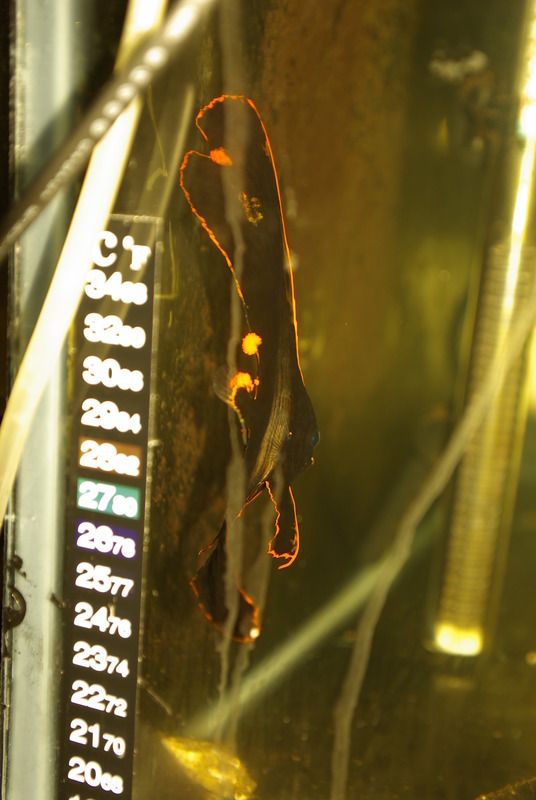 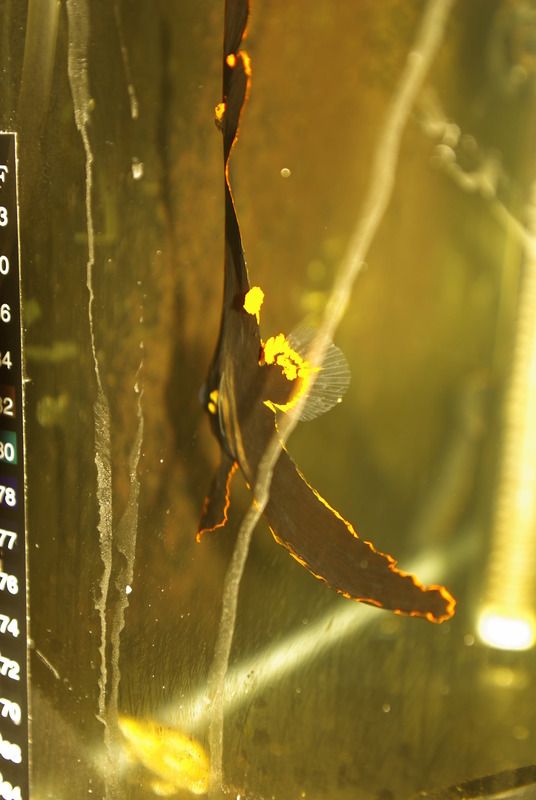 These three are of my Adult\Old Pinnate Batfish who is quite a bit larger now but at least it give you a basic idea. As I said ill post some recent pics of both as soon as I get a chance. 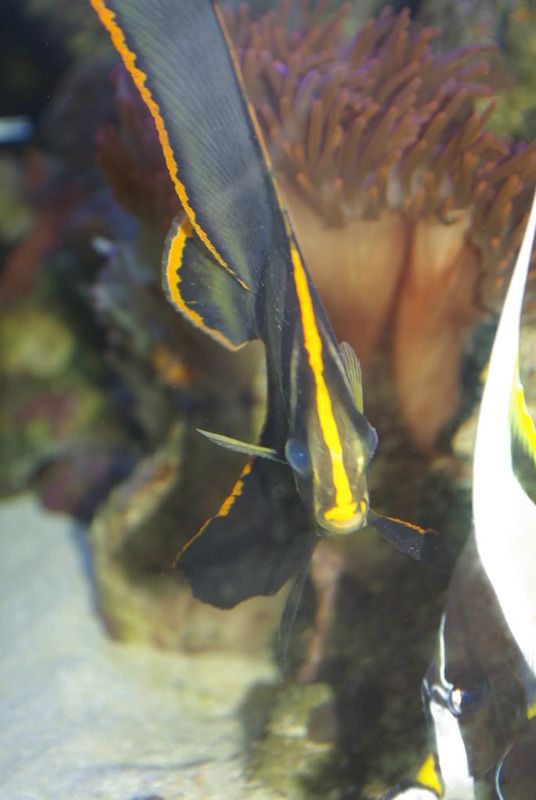 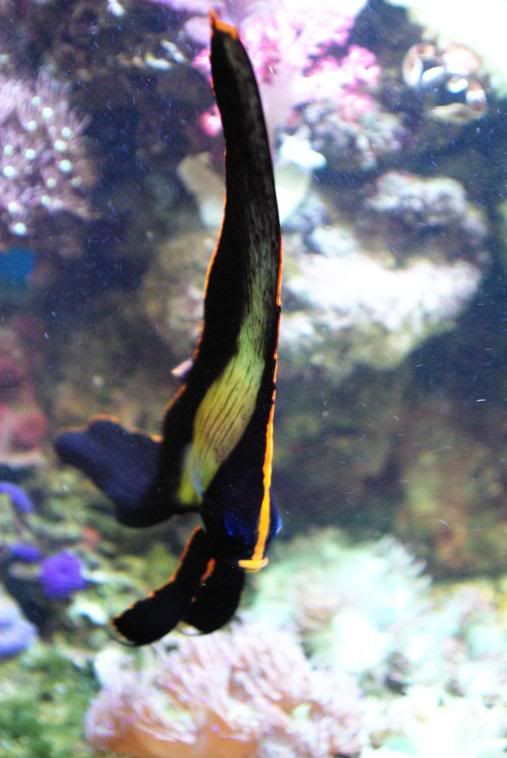 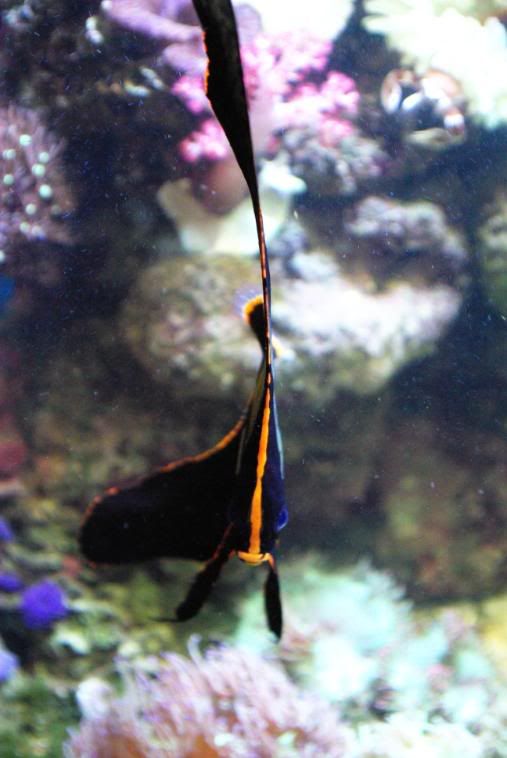
__________________
Jason *A question never asked, is a question never answered. *Two people attempting something differently, doesn't make one of them wrong |
|
|

|
|
|
#7 |
|
Registered Member
Join Date: Sep 2007
Location: Melbourne, Australia
Posts: 379
|
Oh and Jay the observation you made with certain collected specimens spitting their food out is something that I now see as a positive and not a negative through trying to use the above tactic\approach. Will be interesting to see what others think. As I said I would love to breed them once I get enough to be assured a M\F pair. At the moment I cannot tell if there is a difference between the sexes.
__________________
Jason *A question never asked, is a question never answered. *Two people attempting something differently, doesn't make one of them wrong |
|
|

|
|
|
#8 |
|
Registered Member
Join Date: Dec 2008
Location: jacksonville florida
Posts: 1,441
|
So you think a 30" tall tank would be ok?
Nice pics!! Looks like you have a moorish idol there, how's he eating? |
|
|

|
|
|
#9 |
|
Moved On
Join Date: Feb 2010
Location: Wonderland
Posts: 255
|
Mod please sticky this is wonderful information!
30" would be great for a batfish. |
|
|

|
|
|
#10 |
|
Registered Member
Join Date: May 2006
Location: colorado springs,co
Posts: 909
|
my only problem with this fish species was adult size. the ones i held ate anything i put in the tank.
|
|
|

|
|
|
#11 |
|
Moved On
Join Date: Apr 2010
Location: canada, toronto
Posts: 8,161
|
Could these batfish withstand the water movement in a SPS tank ?
are they safe with seahorses ? anyone know ? |
|
|

|
|
|
#12 |
|
Registered Member
Join Date: May 2006
Location: colorado springs,co
Posts: 909
|
no, they hover in the water column so sps flow is out.
SH belong in a species tank. |
|
|

|
|
|
#13 |
|
Registered Member
Join Date: Sep 2007
Location: Melbourne, Australia
Posts: 379
|
Hi All,
Ive taken some recent photos of both Pinnate Batfish in my 8ft mixed reef display. NOTE: The smaller specimen has taken a few nips here and there but nothing to be too concerned about considering everyone is still figuring out their territories etc. Also note the Adult Pinnate shifts colour regularly depending on time of day, light and happiness. I have estimated that my Adult Pinnate is at the older spectrum of their life cycle. 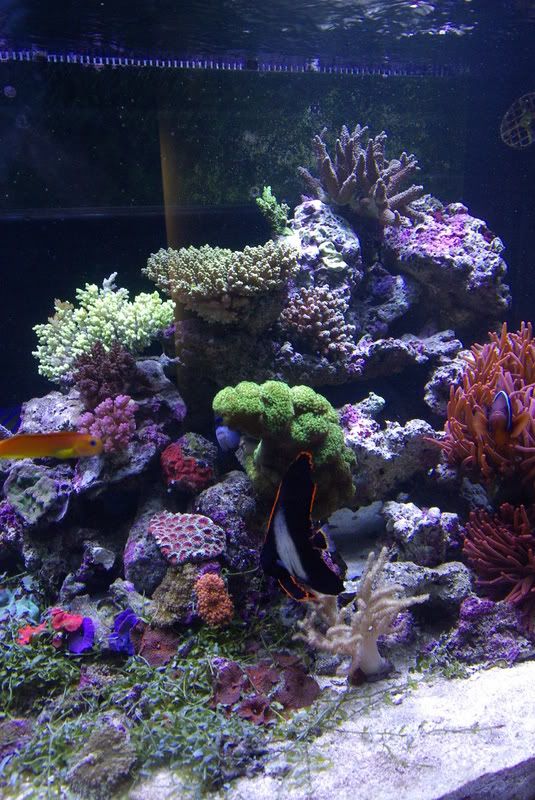 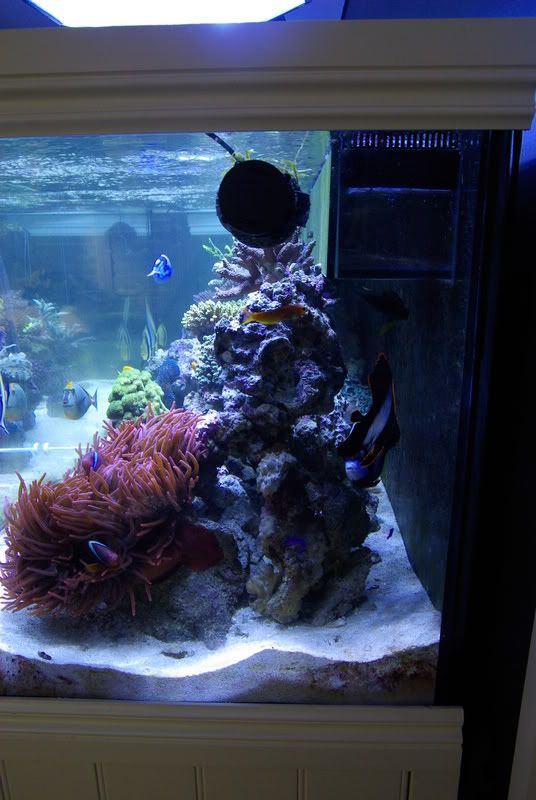 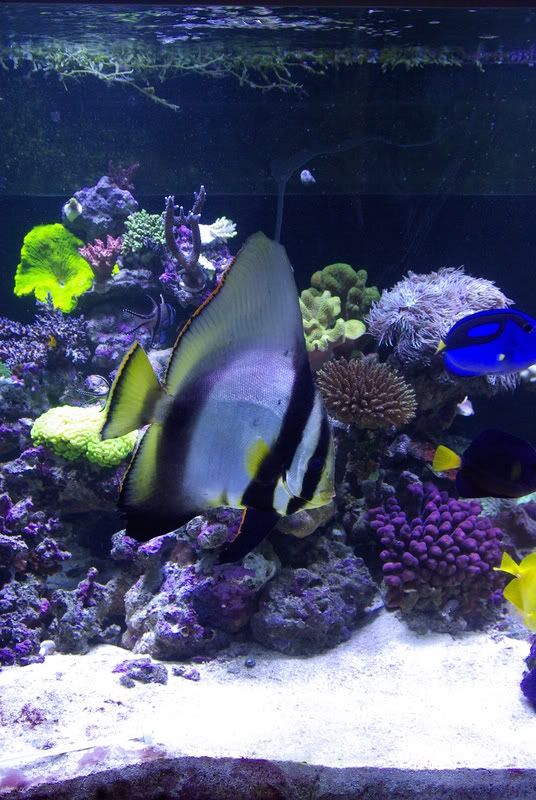 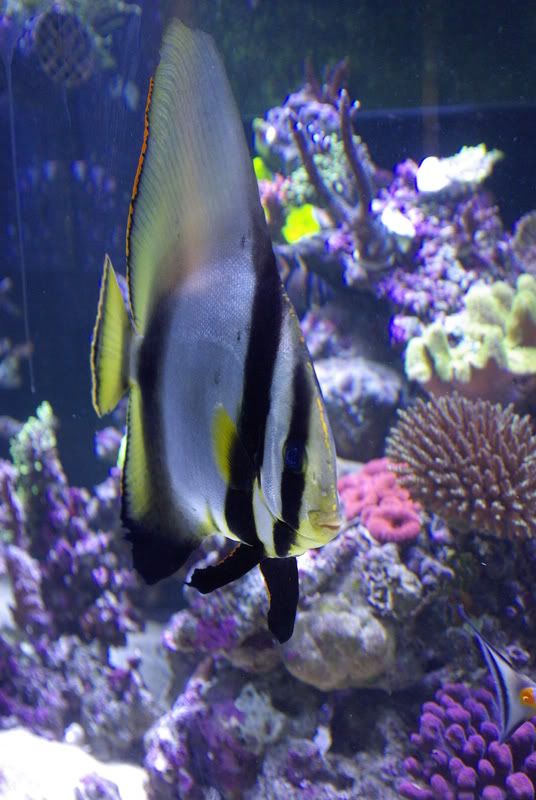 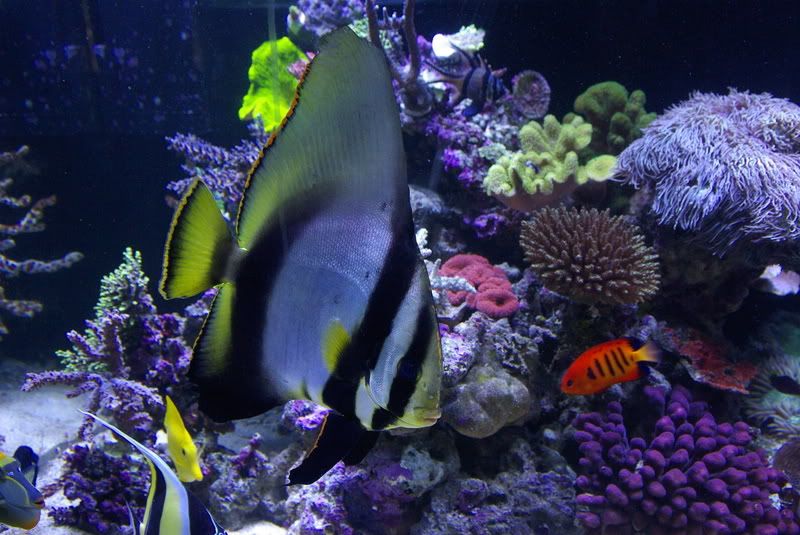 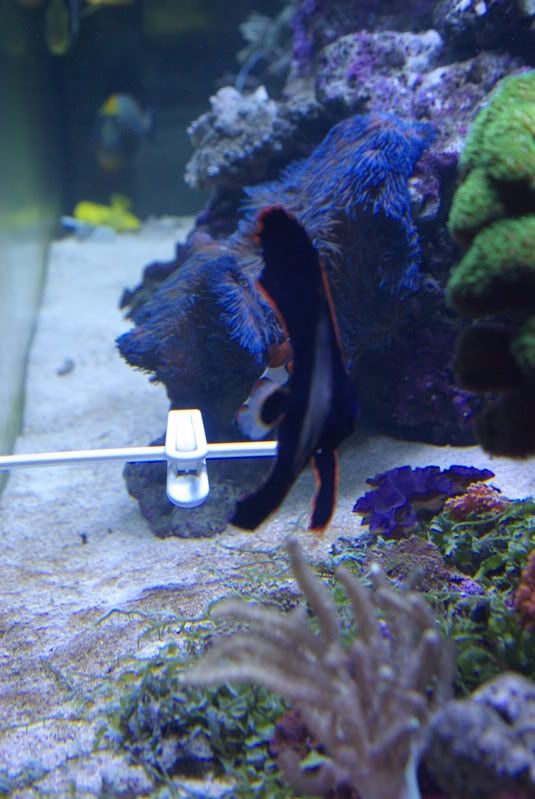 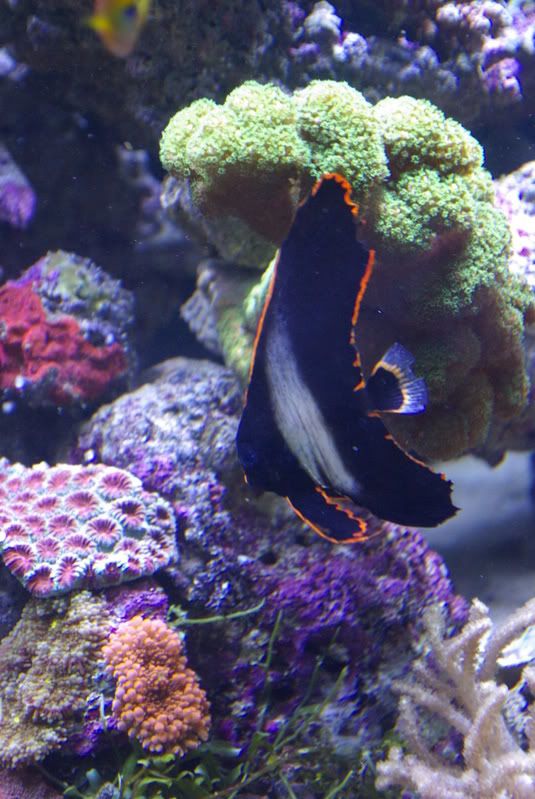 As far as the question goes with the 30" height this is the height of my current display and I feel from my observations that this is an acceptable height for an adult specimen though your depth of sand bed would have to come into consideration as well. Mines only about 4" as im running a 8" DSB in my sump in addition. RE: Moorish Idol, Ive had him just as long as the Pinnate Batfish approx 3+ years. Used a different tactic of getting him eating by using fresh mussels and leaving it on the sand bed for him to pick at. I'm more than happy to answer questions on the Moorish Idol but if you could post them in my tank journal (see my sig) just to keep this thread uncluttered. RE: Flow, my tank is an SPS designed tank. I have the following: 4 x Tunze Turbelle Stream 2 (6205's 5,000 - 22,000 l/h each) Tunze Turbelle Stream 2 - 7096 Multicontroller Tunze Wavebox 6212 & Tunze Wavebox Extension 6212.50 I would say that flow is an issue for juveniles thats for sure but adults enjoy strong flow just as any Tang or Angel would. RE: Sea Horses, my understanding is that these creatures are best kept in a tank of their own. I really couldn't say if they would compliment each other. I guess a juvenile would be fine but as the Pinnate gets older they become and active feeder and would out compete the Sea Horses for food. I spoke with my LFS\Importer who informed me that all of the specimens I own have all been collected from BALI and hit Australian shores within 24 hours of collection. By the sounds of it there are still issues with Cyanide collection but my LFS has been dealing with the same collector for many years and knows the we dont accept any cyanide caught fish no matter how rare\cheap. Hope this helps.
__________________
Jason *A question never asked, is a question never answered. *Two people attempting something differently, doesn't make one of them wrong |
|
|

|
|
|
#14 |
|
Registered Member
Join Date: Mar 2015
Posts: 7
|
Hi Jason, I had a red faced batfish about 5 years ago and it lived 3 years. About 2 months ago I purchased a juvenile red faced bat, that has been doing very well. I just purchased 2 more 5 days ago. During feeding time I blocked off 1/4 of the tank. I went out of the room for 15 minutes and when I came back 2 of them had been fighting and shredded each others fins. Have you experienced this?
Mark |
|
|

|
|
|
#15 |
|
Registered Member
Join Date: Sep 2007
Location: Melbourne, Australia
Posts: 379
|
Hi Mark.
Yes actually I have. I didnt realise they were so territorial. As juveniles they will get along but if you put them in with an adult the adult will pester them to death. Im not sure how to sex them either, actually it seems nobody knows how unless you send them somewhere.
__________________
Jason *A question never asked, is a question never answered. *Two people attempting something differently, doesn't make one of them wrong |
|
|

|
|
|
#16 |
|
Registered Member
Join Date: Mar 2015
Posts: 7
|
Thanks Jason, It seems that besides myself you are the only hobbyist that can get these red faced batfish to grow to adult.
I have found they like the Angel & Butterfly frozen food by San Fransisco Bay Brand inc. www.sfbb.com Of the three juveniles I have, the two that are the most brilliantly orange colored are the two that have the shredded fins. Which makes me think they are males. The other one that is more dull colored has almost no fin damage which makes me think this is a female. But I am only guessing. I have the three juvenile batfish in a 55 gallon tank with an Achilles tang, blond Naso tang (male), Emperor angel (changing), Shark fin ferry wrasse, cleaner wrasse, Bengali Cardinal, Neon Pseudochromis, three blue damsels, and a green chromis. Thank you so much for responding to my question. Mark |
|
|

|
|
|
#17 |
|
Registered Member
Join Date: Mar 2015
Posts: 142
|
They look so different i love them
|
|
|

|
|
|
#18 |
|
Registered Member
Join Date: Mar 2015
Posts: 7
|
Jason, what did you do to stop your batfish from shredding each others fins?
Mark |
|
|

|
|
|
#19 |
|
Registered Member
Join Date: Dec 2016
Posts: 11
|
What size to they start changing?
(sorry if this question was already asked) |
|
|

|
|
|
#20 |
|
Registered Member
Join Date: Dec 2015
Location: Mendham, NJ USA
Posts: 395
|
Mine started "changing" from day one. The older they get the more the red bar shrinks and gets duller in color. I think it was about 6 inches from head to tail when it had lost all orange color on edges of fins.
|
|
|

|
|
|
#21 | |
|
Registered Member
Join Date: Sep 2007
Location: Melbourne, Australia
Posts: 379
|
Quote:
__________________
Jason *A question never asked, is a question never answered. *Two people attempting something differently, doesn't make one of them wrong |
|
|
|

|
|
|
#22 |
|
Registered Member
Join Date: Oct 2002
Location: South Euclid, OH
Posts: 4,281
|
Here was mine that I had back more than 20 years ago. He was about 7-8" top to bottom in this picture.
I bought him large at about 5" He gorged on fresh frozen chopped scallops, shrimp, mussels, clams, mysis. 
__________________
80g Rimless Acropora System reefcentral.com/forums/showthread.php?t=2197142&page=31 Ed |
|
|

|
|
|
#23 |
|
Reef keeper
Join Date: Sep 2007
Location: 70° 17' 59.176"/-83° 6' 27.2768"
Posts: 5,734
|
Bump, any updates?
__________________
-Moses, the reef/azoox nut. Food comes with it's own flavor. Anything that has to steal flavor from other food just so it can have flavor is not a food. That is Current Tank Info: 120 gallon Mixed Reef, mostly SPS dominated |
|
|

|
|
|
#24 |
|
Registered Member
Join Date: Sep 2007
Location: Melbourne, Australia
Posts: 379
|
What would you like to know?
__________________
Jason *A question never asked, is a question never answered. *Two people attempting something differently, doesn't make one of them wrong |
|
|

|
 |
|
|
 Similar Threads
Similar Threads
|
||||
| Thread | Thread Starter | Forum | Replies | Last Post |
| Pinnate batfish on LA? | JamesJR | Reef Fishes | 15 | 03/17/2010 09:53 AM |
| Strange growths. Disease ID please. Pinnate Batfish | r0cksteady | Fish Disease Treatment | 6 | 03/16/2010 10:41 AM |
| Pinnate Batfish - Breeding | r0cksteady | The Fish Breeding Forum | 1 | 04/29/2009 09:18 PM |
| White mark on pinnate batfish since tank move | r0cksteady | Fish Disease Treatment | 2 | 01/26/2009 02:49 PM |
| Platax pinnatus | Nockner | Reef Fishes | 6 | 06/24/2006 09:04 AM |